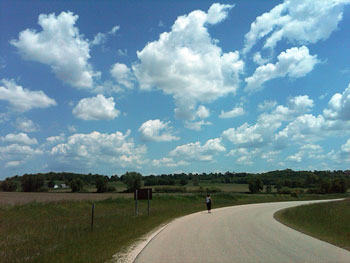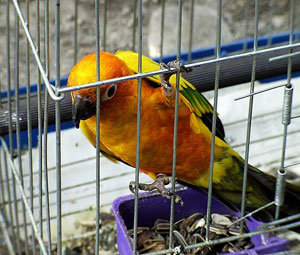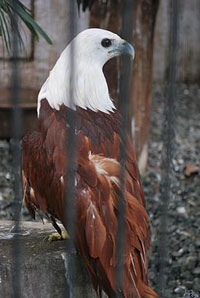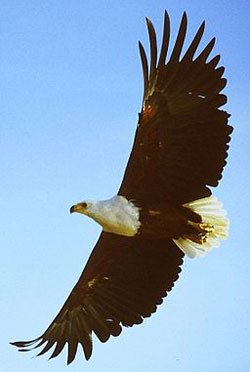Just as poets sometimes use metaphor, they might also use symbols to express a deeper meaning. When you read a poem, look for an object that has meaning in itself but that also suggests something else.
Read the following poem “Up-Hill” by the nineteenth-century poet Christina Rossetti. The poet uses a question and answer format to relay her point about an uphill journey.

Source: The Long and Winding Road, bbnick42, Flickr
Up-Hill
Does the road wind up-hill all the way?
Yes, to the very end.
Will the day’s journey take the whole long day?
From morn to night, my friend.
But is there for the night a resting-place?
A roof for when the slow dark hours begin.
May not the darkness hide it from my face?
You cannot miss that inn.
Shall I meet other wayfarers at night?
Those who have gone before.
Then must I knock, or call when just in sight?
They will not keep you standing at that door.
Shall I find comfort, travel-sore and weak?
Of labour you shall find the sum.
Will there be beds for me and all who seek?
Yea, beds for all who come.
 At first glance, this poem is simply about a traveler preparing for a journey. However, the poem has a deeper, symbolic meaning, too. Use your notes to answer the questions below that will help you understand the symbolism of the poem. When you are finished, check your understanding to see possible responses.
At first glance, this poem is simply about a traveler preparing for a journey. However, the poem has a deeper, symbolic meaning, too. Use your notes to answer the questions below that will help you understand the symbolism of the poem. When you are finished, check your understanding to see possible responses. - In line 3, the speaker asks, “Will the journey take all day?” and is told that it will take “from morn to night.” What might the journey represent?
- The speaker mentions an “inn” in line 8. Considering your previous answer, what might the inn represent?
- Who are the “other wayfarers” and “those who have gone before”?
- Is the poem’s end optimistic or pessimistic? How do you know?
Sample Responses:
- The journey is a person’s life and the path he will take from birth to death (“from morn to night”).
- The inn could represent an afterlife.
- These terms represent people who have died before we have.
- The poem is optimistic because the speaker states that at your journey’s end (death), you will find comfort and rest.

Source: Bird in cage, High Contrast, Wikimedia
One of the most famous present-day poets is the African-American poet Maya Angelou. Read her poem “Caged Bird” by clicking the link. Return to this section when you are finished reading.
 Drawing upon your knowledge of the treatment of African Americans before the civil rights movement, answer the following questions using your notes. When you are finished, check your understanding to see possible responses.
Drawing upon your knowledge of the treatment of African Americans before the civil rights movement, answer the following questions using your notes. When you are finished, check your understanding to see possible responses. - What phrases does Angelou use to represent the caged bird?
- What phrases does Angelou use to represent the free bird?
- Judging from the contrast of these two descriptions, what do you believe each bird (the caged bird and the free bird) symbolize?
Sample Responses:
- He “stalks” in his cage; “his wings are clipped and his feet are tied”; he sings fearfully.
- He “leaps on the back of the wind”; he “floats downstream”; he “dips his wings“; he “claim[s] the sky”; and “he names the sky his own.”
- The caged bird symbolizes African Americans before their rights were granted. They were not free to do what they wanted. The white population comprises the free birds. They have options and freedom to do as they choose.

Source: Brahminy kite caged, Jpogi, Wikimedia

Source: African fish eagle flying cropped, Mehmet Karatay, Wikimedia
While Angelou’s poem on the surface seems like it’s about two birds—one in a cage and one in the sky—when you look for a deeper meaning, you can find one. In this poem, the birds are not just winged creatures; they represent anyone who has been enslaved and anyone who has lived in freedom.